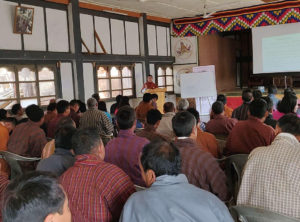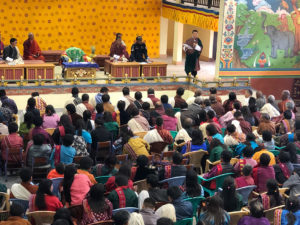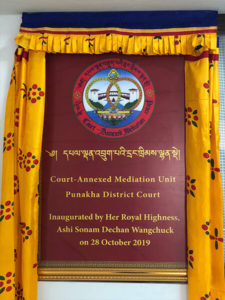News
Modern Mediation Developments in Bhutan – Court Annexed Mediation
Historical Background
 Bhutan has a long history of resolving disputes through mechanisms, such as mediation. According to some sources, traditional mediation, commonly known as nangkha nangdrik in Bhutanese, has been an integral part of Bhutanese culture and tradition, dating back to the 7th century. Since a formal justice system developed in Bhutan only in the early 1960s, for centuries mediation did not exist as an alternative to a formal justice system, but as a primary dispute resolution mechanism.
Bhutan has a long history of resolving disputes through mechanisms, such as mediation. According to some sources, traditional mediation, commonly known as nangkha nangdrik in Bhutanese, has been an integral part of Bhutanese culture and tradition, dating back to the 7th century. Since a formal justice system developed in Bhutan only in the early 1960s, for centuries mediation did not exist as an alternative to a formal justice system, but as a primary dispute resolution mechanism.
The mediation process was based on the principles of compassion and peaceful coexistence, important aspects of the community-oriented Bhutanese society. This traditional practice has waned over the last decades, however, and recent efforts have strived to revive it since 2012.
Modern Formalization of Mediation Practice in Bhutan
The legal formalization of the practice of mediation in Bhutan derives from sections DA 3-1 & DA 3-2 of the Thrimzhung Chenmo (Supreme Law) of 1953. The option to resolve a civil dispute through mediation is incorporated under section 150 of the Civil and Criminal Procedure Code (Amendment Act 2011), and the Alternative Dispute Resolution Act of Bhutan 2013. Judges in Bhutan are mandated by law to inform litigants of their right to mediate their disputes out of court. While the importance of negotiated settlements is recognized by the judicial system, there is no procedural mechanism established for conducting the mediation process. Thus, mediation procedures have varied widely, depending on who conducts the mediation and local practice.
 The Bhutan National Legal Institute (BNLI) has been providing training to mediators and educating the public about the beneficial use of mediation ever since 2012. In conformity with modern mediation standards, Bhutan has been restructuring its practice to provide a process that is interest-based and facilitative in nature. Mediators now understand that confidentiality is at the core of the mediation process.
The Bhutan National Legal Institute (BNLI) has been providing training to mediators and educating the public about the beneficial use of mediation ever since 2012. In conformity with modern mediation standards, Bhutan has been restructuring its practice to provide a process that is interest-based and facilitative in nature. Mediators now understand that confidentiality is at the core of the mediation process.
Private or commercial mediations are increasing in Bhutan. At the same time, the traditional mediation system has been reinvigorated with community mediation services, which are always provided free of cost. The parties have the option either to go for commercial mediation or community mediation centers.
Establishment of Court-Annexed Mediation
The Bhutan National Legal Institute (BNLI) recently introduced court-annexed mediation in courts throughout the country on October 28, 2019, as a significant judicial reform. With the introduction of these mediation units within the courts, people will have enhanced access to prompt and speedy justice, in addition to strengthening community vitality, preserving relationships between the people and promoting the Gross National Happiness of Bhutan.
 This is a bit different from how mediation used to happen before. In the absence of mediation units in courts, if the parties wish to opt for mediation, their disputes are resolved either from private or commercial mediations or from community mediation centers. In this new system, judges can refer appropriate civil cases to the Court-Annexed Mediation Unit (CAMU) for judicial mediation; alternatively, the parties can request the judges to adjourn the cases and refer their cases to in-house judicial mediation services after the initalization of the case, any time, before the judgments are rendered. The mediation services are being provided by the trained and skilled judicial mediators at no cost. If the mediations are successful, the courts will endorse the settlement agreements and render judgements thereon, and enforce accordingly. If the mediations fail the case will be reverted for adjudication as per the laws.
This is a bit different from how mediation used to happen before. In the absence of mediation units in courts, if the parties wish to opt for mediation, their disputes are resolved either from private or commercial mediations or from community mediation centers. In this new system, judges can refer appropriate civil cases to the Court-Annexed Mediation Unit (CAMU) for judicial mediation; alternatively, the parties can request the judges to adjourn the cases and refer their cases to in-house judicial mediation services after the initalization of the case, any time, before the judgments are rendered. The mediation services are being provided by the trained and skilled judicial mediators at no cost. If the mediations are successful, the courts will endorse the settlement agreements and render judgements thereon, and enforce accordingly. If the mediations fail the case will be reverted for adjudication as per the laws.
By Judge Pema Needup, Senior Fellow-Bhutan, Weinstein International Foundation

